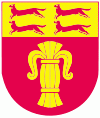Ostrobothnia (Pohjanmaa)
 |
Ostrobothnia is one of two Finnish regions with a Swedish-speaking majority (the other being the constitutionally monolingual province of Åland); Swedish-speakers make up 51.2% of the total population. The region contains thirteen bilingual municipalities and one that is exclusively Finnish-speaking. The capital of Vaasa is predominantly inhabited by Finnish speakers, whereas smaller towns and rural areas are generally dominated by the Swedish language. The three municipalities with the largest number of Swedish speakers are Korsholm, Jakobstad and Pedersöre.
Geographically, Ostrobothnia has little topographical relief, because it is mostly former seafloor brought to surface by post-glacial rebound and the accumulation of alluvial sediment. Ostrobothnia has both vast expanses of cultivated fields (lakeus) as in Southern Ostrobothnia, and the archipelago of Kvarken (Finnish: Merenkurkku). Glacial transport has deposited large quantities of rocks in the area. Like elsewhere in Pohjanmaa, rivers are a prominent part of the landscape. The major rivers that discharge into the Gulf of Bothnia in Ostrobothnia are Kyrönjoki, Lapuanjoki and Ähtävänjoki.
Kaskinen, a coastal town located in the southern part of the region, is the smallest town in Finland in terms of both area and population.
Prior to the officialization of the names of the Finnish regions, Ostrobothnia was also known as Vasa kustregionen in Swedish and Vaasan rannikkoseutu in Finnish, both of which translate into "[the] coastal region of Vaasa". The Institute for the Languages of Finland recommended that the region be named Kustösterbotten in Swedish and Rannikko-Pohjanmaa in Finnish, meaning "coastal Ostrobothnia" in English. However, upon the confirmation of the names of the Finnish regions on 26 February 1998, the current name of the region was officialized instead, according to the wishes of the regional government. The central government cited the Swedish language's prevalence in the region, as well as the lack of a common consensus on an alternative name the reasons for its decision. In local circles or communities, Ostrobothnia is often referred to as "Pampas". The word derives from the similarities in the flat landscape with the Pampas area in South America.
The regional tree is the black alder (Alnus glutinosa), the regional mammal is the common elk (Alces alces), the regional stone is Vaasa granite and the regional song is "The march of Vaasa" (Vasamarschen, Vaasan marssi).
Map - Ostrobothnia (Pohjanmaa)
Map
Country - Finland
 |
 |
| Flag of Finland | |
Finland was first inhabited around 9000 BC after the Last Glacial Period. The Stone Age introduced several different ceramic styles and cultures. The Bronze Age and Iron Age were characterized by contacts with other cultures in Fennoscandia and the Baltic region. From the late 13th century, Finland became a part of Sweden as a consequence of the Northern Crusades. In 1809, as a result of the Finnish War, Finland became part of the Russian Empire as the autonomous Grand Duchy of Finland, during which Finnish art flourished and the idea of independence began to take hold. In 1906, Finland became the first European state to grant universal suffrage, and the first in the world to give all adult citizens the right to run for public office. After the 1917 Russian Revolution, Finland declared independence from Russia. In 1918, the fledgling state was divided by the Finnish Civil War. During World War II, Finland fought the Soviet Union in the Winter War and the Continuation War, and Nazi Germany in the Lapland War. It subsequently lost parts of its territory, but maintained its independence.
Currency / Language
| ISO | Currency | Symbol | Significant figures |
|---|---|---|---|
| EUR | Euro | € | 2 |
| ISO | Language |
|---|---|
| FI | Finnish language |
| SV | Swedish language |
















